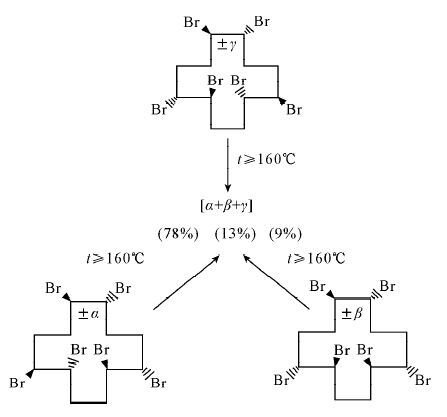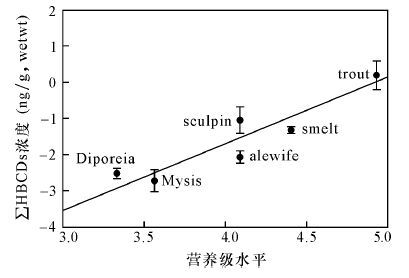| [1] |
Son M H,Kim J K,Shin E S,et al. Diastereoisomer- and Species-specific Distribution of Hexabromocyclododecane (HBCD) in Fish and Marine Invertebrates[J].Journal of Hazard Materials,2015,300:114-120. doi: 10.1016/j.jhazmat.2015.06.023
CrossRef Google Scholar
|
| [2] |
Law R J,Covaci A,Harrad S,et al.Levels and Trends of PBDEs and HBCDs in the Global Environment:Status at the End of 2012[J].Environment International,2014,65(2):147-158.
Google Scholar
|
| [3] |
Vorkamp K,Bossi R,Rigét F F,et al.Novel Brominated Flame Retardants and Dechlorane Plus in Greenland Air and Biota[J].Environmental Pollution,2015,196:284-291. doi: 10.1016/j.envpol.2014.10.007
CrossRef Google Scholar
|
| [4] |
Zeng Y H,Luo X J,Zheng X,et al.Species-specific Bioaccumulation of Halogenated Organic Pollutants and Their Metabolites in Fish Serum from an E-waste Site,South China[J].Archives of Environmental Contamination & Toxicology,2014,67(3):348-357.
Google Scholar
|
| [5] |
罗孝俊,吴江平,陈社军,等.多溴联苯醚、六溴环十二烷和得克隆的生物差异性富集及其机理研究进展[J].中国科学(化学),2013,43:291-304. doi: 10.1360/032013-9
CrossRef Google Scholar
Luo X J,Wu J P,Chen S J,et al.Species-specific Bioaccumulation of Polybrominated Diphenyl Ethers,Hexabromocyclododecane and Dechlorane Plus in Biota:A Review[J].Scientia Sinica Chimica,2013,43(3):291-304. doi: 10.1360/032013-9
CrossRef Google Scholar
|
| [6] |
Abbasi N A,Malik R N,Frantz A,et al.A Review on Current Knowledge and Future Prospects of Organohalogen Contaminants (OHCs) in Asian Birds[J].Science of the Total Environment,2016,542(Part A):411-426.
Google Scholar
|
| [7] |
Yu G,Bu Q,Cao Z,et al.Brominated Flame Retardants (BFRs):A Review on Environmental Contamination in China[J].Chemosphere,2016,150:479-490. doi: 10.1016/j.chemosphere.2015.12.034
CrossRef Google Scholar
|
| [8] |
Koch C,Schmidt-Kötters T,Rupp R,et al.Review of Hexabromo-cyclododecane (HBCD) with a Focus on Legislation and Recent Publications Concerning Toxicokinetics and Dynamics[J]. Environmental Pollution,2015,199:26-34. doi: 10.1016/j.envpol.2015.01.011
CrossRef Google Scholar
|
| [9] |
张艳伟.六溴环十二烷异构体及其对映体的环境分布与生物富集[D].天津:南开大学,2014.http://cdmd.cnki.com.cn/Article/CDMD-10055-1015528868.htm
Google Scholar
Zhang Y W.Environmental Distribution and Bioaccumulation of Hexabromoclododecane Diastereomers and Enantiomers[D].Tianjin:Nankai University,2014.
Google Scholar
|
| [10] |
Hendriks H S,Westerink R H S.Neurotoxicity and Risk Assessment of Brominated and Alternative Flame Retardants[J].Neurotoxicology and Teratology,2015,52(Part B):248-269.
Google Scholar
|
| [11] |
Millera I,Serchib T,Cambierb S,et al.Hexabromocyclo-dodecane (HBCD) Induced Changes in the Liver Proteome of Eu- and Hypothyroid Female Rats[J].Toxicology Letters,2016,245:40-51. doi: 10.1016/j.toxlet.2016.01.002
CrossRef Google Scholar
|
| [12] |
Kim U J,Oh J E.Tetrabromobisphenol A and Hexabromocyclododecane Flame Retardants in Infant-Mother Paired Serum Samples, and Their Relationships with Thyroid Hormones and Environmental Factors[J].Environmental Polluttion,2014,184(1):193-200.
Google Scholar
|
| [13] |
Rawn D F K,Gaertner D W,Weber D,et al.Hexabromo-cyclododecane Concentrations in Canadian Human Fetal Liver and Placental Tissues[J].Science of the Total Environment,2014,468-469C:622-629.
Google Scholar
|
| [14] |
Barontini F,Cozzani V,Petarca L.Thermal Stability and Decomposition Products of Hexabromocyclododecane[J].Industrial & Engineering Chemistry Research,2003,40(15):3270-3280.
Google Scholar
|
| [15] |
Hunziker R W,Gonsior S,McGergor J A,et al.Fate and Effect of Hexabromocyclododecane in the Environment[J].Organohalogen Compounds,2004,66:2300-2305.
Google Scholar
|
| [16] |
Wu T,Wang S,Huang H,et al.Diastereomer-specific Uptake,Translocation,and Toxicity of Hexabromocyclo-dodecane Diastereoisomers to Maize[J].Journal of Agricultural & Food Chemistry,2012,60(34):8528-8534.
Google Scholar
|
| [17] |
Du M,Zhang D,Yan C,et al.Developmental Toxicity Evaluation of Three Hexabromocyclododecane Diastereoisomers on Zebrafish Embryos[J].Aquatic Toxicology,2012,112-113(2):1-10.
Google Scholar
|
| [18] |
Zhang X,Yang F,Xu C,et al.Cytotoxicity Evaluation of Three Pairs of Hexabromocyclododecane (HBCD) Enantiomers on HepG2 Cell[J].Toxicology in Vitro:An International Journal Published in Association with Bivra,2008,22(6):1520-1527. doi: 10.1016/j.tiv.2008.05.006
CrossRef Google Scholar
|
| [19] |
Covaci A,Gerecke A C,Law R J,et al.Hexabromocy-clododecanes (HBCDs) in the Environment and Humans:A Review[J].Environmental Science & Technology,2006,40(12):3679-3688.
Google Scholar
|
| [20] |
Tomy G T,Pleskach K,Oswald T,et al.Enantioselective Bioaccumulation of Hexabromocyclododecane and Congener-specific Accumulation of Brominated Diphenyl Ethers in an Eastern Canadian Arctic Marine Food Web[J].Environmental Science & Technology,2008,42(10):3634-3639.
Google Scholar
|
| [21] |
Wu J P,Guan Y T,Zhang Y,et al.Trophodynamics of Hexabromocyclododecanes and Several Other Non-PBDE Brominated Flame Retardants in a Freshwater Food Web[J].Environmental Science & Technology,2010,44(14):5490-5495.
Google Scholar
|
| [22] |
Brandsma S H,Leonards P E G,Leslie H A,et al.Tracing Organophosphorus and Brominated Flame Retardants and Plasticizers in an Estuarine Food Web[J].Science of the Total Environment,2015,505:22-31. doi: 10.1016/j.scitotenv.2014.08.072
CrossRef Google Scholar
|
| [23] |
Morris S,Allchin C R,Zegers B N,et al.Distribution and Fate of HBCD and TBBPA Brominated Flame Retardants in North Sea Estuaries and Aquatic Food Webs[J].Environmental Science & Technology,2004,38(21):5497-5504.
Google Scholar
|
| [24] |
Zhang Y,Sun H,Liu F,et al.Hexabromocyclododecanes in Limnic and Marine Organisms and Terrestrial Plants from Tianjin,China:Diastereomer- and Enantiomer-specific Profiles,Biomagnification,and Human Exposure[J].Chemosphere,2013,93(8):1561-1568. doi: 10.1016/j.chemosphere.2013.08.004
CrossRef Google Scholar
|
| [25] |
Law K,Halldorson T,Danell R,et al.Bioaccumulation and Trophic Transfer of Some Brominated Flame Retardants in a Lake Winnipeg (Canada) Food Web[J].Environmental Toxicology & Chemistry,2006,25(8):2177-2186.
Google Scholar
|
| [26] |
Tomy G T,Budakowsti W,Halldorson T,et al.Biomagnification of α- and γ-Hexabromacyclododecane Isomers in a Lake Ontario Food Web[J].Environmental Science & Technology,2004,38(8):2298-2303.
Google Scholar
|
| [27] |
Yu L,Luo X,Zheng X,et al.Occurrence and Biomagnification of Organohalogen Pollutants in Two Terrestrial Predatory Food Chains[J].Chemosphere,2013,93:506-511. doi: 10.1016/j.chemosphere.2013.06.023
CrossRef Google Scholar
|
| [28] |
Sørmo E G,Salmer M P,Jenssen B M,et al.Biomagni-fication of Polybrominated Diphenyl Ether and Hexabromocyclododecane Flame Retardants in the Polar Bear Food Chain in Svalbard,Norway[J].Environmental Toxicology & Chemistry,2006,25:2502-2511.
Google Scholar
|
| [29] |
Tomy G T,Pleskach K,Ferguson S H,et al.Trophody-namics of Some PFCs and BFRs in a Western Canadian Arctic Marine Food Web[J].Environmental Science & Technology,2009,43(11):4076-4081.
Google Scholar
|
| [30] |
Conder J M,Gobas F A P C,Borg K,et al.Use of Trophic Magnification Factors and Related Measures to Characterize Bioaccumulation Potential of Chemicals[J].Integrated Environmental Assessment and Management,2012,8(1):85-97. doi: 10.1002/ieam.216
CrossRef Google Scholar
|
| [31] |
Haukas M,Hylland K,Nygard T,et al.Diastereomer-specific Bioaccumulation of Hexabromocyclododecane (HBCD) in a Coastal Food Web,Western Norway[J].Science of the Total Environment,2010,408(23):5910-5916. doi: 10.1016/j.scitotenv.2010.08.026
CrossRef Google Scholar
|
| [32] |
Poma G,Volta P,Roscioli C,et al.Concentrations and Trophic Interactions of Novel Brominated Flame Retardants,HBCD,and PBDEs in Zooplankton and Fish from Lake Maggiore (Northern Italy)[J].Science of the Total Environment,2014,481:401-408. doi: 10.1016/j.scitotenv.2014.02.063
CrossRef Google Scholar
|
| [33] |
Zegers B N,Mets A,van Bommel R,et al.Levels of Hexabromocyclododecanein Harbor Porpoises and Common Dolphins from Western European Seas,with Evidence for Stereoisomer-specific Biotransformation by Cytochrome P450[J].Environmental Science & Technology,2005,39(7):2095-2100.
Google Scholar
|
| [34] |
Law K,Palace V P,Halldorson T H J,et al.Dietary Accumulation of Hexabromocyclododecane Diastereomers in Juvenile Rainbow Rout (Oncorhynchusmykiss).Ⅰ:Bioaccumulation Parameters and Evidence of Bioisomerization[J].Environmental Toxicology & Chemistry,2006,25(7):1757-1761.
Google Scholar
|
| [35] |
Du M,Lin L,Yan C,et al.Diastereoisomer- and Enantiomer-specific Accumulation,Depuration,and Bioisomerization of Hexabromocyclododecanes in Zebrafish (Danio rerio)[J].Environmental Science & Technology,2012,46(20):11040-11046.
Google Scholar
|
| [36] |
Li B,Yao T,Sun H,et al.Diastereomer- and Enantio-mer-specific Accumulation, Depuration, Bioisomerization, and Metabolism of Hexabromocyclo-dodecanes (HBCDs) in Two Ecologically Different Species of Earthworms[J].Science of the Total Environment,2016,542(Part A):427-434.
Google Scholar
|
| [37] |
Luo X J,Ruan W,Zeng Y H,et al.Trophic Dynamics of Hexabromocyclododecane Diastereomers and Enantiomers in Fish in a Laboratory Feeding Study[J].Environmental Toxicology & Chemistry,2013,32(11):2565-2570.
Google Scholar
|
| [38] |
Li Y,Zhou Q,Wang Y,et al.Fate of Tetrabromo-bisphenol A and Hexabromocyclododecane Brominated Flame Retardants in Soil and Uptake by Plants[J].Chemosphere,2011,82(2):204-209. doi: 10.1016/j.chemosphere.2010.10.021
CrossRef Google Scholar
|
| [39] |
焦杏春,路国慧,王晓春,等.环境中溴系阻燃剂六溴环十二烷的水平及分析进展[J].岩矿测试,2012,31(2):210-217.
Google Scholar
Jiao X C,Lu G H,Wang X C,et al.The Levels and Analytical Developments of Brominated Flame Retardant Hexabromocyclodocanes from Various Environmental Media[J].Rock and Mineral Analysis,2012,31(2):210-217.
Google Scholar
|
| [40] |
He M,Luo X,Yu L,et al.Tetrabromobisphenol-A and Hexabromocyclododecane in Birds from an E-waste Region in South China:Influence of Diet on Diastereoisomer- and Enantiomer-specific Distribution and Trophodynamics[J].Environmental Science & Technology,2010,44(15):5748-5754.
Google Scholar
|
| [41] |
Sun Y,Luo X,Mo L,et al.Hexabromocyclododecane in Terrestrial Passerine Birds from E-waste,Urban and Rural Locations in the Pearl River Delta, South China:Levels,Biomagnification,Diastereoisomer- and Enantiomer-specific Accumulation[J].Environmental Pollution,2012,171(4):191-198.
Google Scholar
|
| [42] |
Janák K,Covaci A,Voorspoels S,et al.Hexabromocyclo-dodecane in Marine Species from the Western Scheldt Estuary:Diastereoisomer- and Enantiomer-specific Accumulation[J].Environmental Science & Technology,2005,39(7):1987-1994.
Google Scholar
|
| [43] |
Esslinger S,Becker R,Maul R,et al.Hexabromocyclo-dodecane Enantiomers:Microsomal Degradation and Patterns of Hydroxylated Metabolites[J].Environmental Science & Technology,2011,45(9):3938-3944.
Google Scholar
|
| [44] |
Zhang Y,Sun H,Ruan Y.Enantiomer-specific Accumu-lation,Depuration,Metabolizationand Isomerization of Hexabromocyclododecane (HBCD) Diastereomers in Mirror Carp from Water[J].Journal of Hazardous Materials,2014:264(10):8-15.
Google Scholar
|







 DownLoad:
DownLoad:

